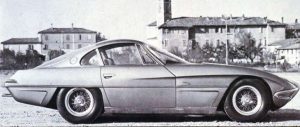
The history of ‘Lamborghini Automobili’ officially starts in 1963 founded by Ferruccio Lamborghini, by the time he decided to build a factory of luxury sports cars, Ferruccio was already a very wealthy man. In the period following World War II, he founded his tractor factory, which he launched with energy and determination, creating a major point of reference in this industry. Other businesses followed, and he amassed his fortune at the perfect time, before his fiftieth birthday. By the early Sixties, Lamborghini was a powerful and successful man who knew exactly what he wanted, but when he said he would build a super sports car to compete with Ferrari, many people thought he was mad. Constructing that kind of car was viewed as an unexplainable extravagance, a hazardous leap in the dark, and something that would squander his fortune without ever turning a profit.
He started working on this project in late 1962, and by May 1963 he had already founded ‘ Automobili Ferruccio Lamborghini’, buying a large plot of land in Sant’Agata Bolognese, about 25 kilometres from Bologna, to build a new large and ultramodern factory. Because of the experience he had gained with his other companies, he was in a position to set up the best facilities for his purpose: a very functional structure that, at the time, was unrivalled in its field. The enormous and well-let central building was adjacent to the office building, so that the management could constantly monitor the production situation. This was ideal for Lamborghini, who would often roll up his shirtsleeves and go to work on the cars personally when he saw something that wasn’t done just the way he wanted.
The first model was naturally put out quickly, given that Lamborghini had only a few months between the time he decided to build the factory and the date set for its official presentation. The event that was chosen for this was the era’s traditional rendezvous, the Turin Auto Show scheduled for the beginning of November 1963. Since Lamborghini had a very clear idea of what he wanted, he didn’t waste any time looking for the right people. For the engine, which had to be the best V12 made in the area – and thus in the world – he immediately turned to Giotto Bizzarrini, who had designed some of Ferrari’s most recent engines. For the rest of the car and to start up production, he hired two promising young engineers, Giampaolo Dallara and Giampaolo Stanzani. This was a considerable endeavour and time was short Nevertheless, when the 350 GTV, was presented it was already a masterpiece.
In retrospect, 1964 was an extraordinary year. The 350 GT was born. The immediate and almost inevitable offshoot of the 350 GT, of which 120 were built, was the 400 GT. Its engine was increased to a four-litre model and it featured the first gearbox designed in-house by Lamborghini. Based initially on the two-seater body, which was later developed into the 400 GT 2+2 with two occasional seats behind the two regular ones, the 400 GT reached the respectable overall production figure of 273 units.
1963 Lamborghini 350 GTV
Automobili Lamborghini S.p.A. was founded in 1963 in Sant’Agata Bolognese, a small village between Bologna and Modena, Italy, by Ferruccio Lamborghini. The company’s first car, the 350 GTV was introduced at the Turin Motor Show in the fall of 1963 and the production started, with the model 350 GT the year after.
The twelve-cylinder at the heart of the brand with the bull Lamborghini V12 – a long and glorious story. According to the history books, Ferruccio Lamborghini established a car company in the early sixties because he wanted to better the products on offer at the time from the competition, with the best possible technology and quality. The prototype for all later Lamborghini super sports cars was the 350 GTV study presented at the Turin Motor Show in 1963.
It featured an all-new aluminium twelve-cylinder developed from scratch by engine designer Giotto Bizzarrini and boasted performance figures that were nothing short of breathtaking by the standards of the time. The 12-cylinder V-engine with 60 degree cylinder bank angle, four overhead camshafts (at a time when single camshafts were still the norm), a six bbl carburetor and dry sump lubrication, generated 360 hp at 8,000 rpm from a displacement of 3,497 cm3 that would take the concept car to a top speed of 280 km/h. The 350 GT series production version with conventionallubrication launched the following year produced 320 hp at 7,000 rpm from adisplacement of 3,464 cm3.
- After the presentation of the first prototype in 1963, the 350 GTV was mass-produced a year later.
- The name was changed to 350 GT and several modifications to the car’s bodywork were made.
- The car was an immediate success. 120 units were produced, the majority with the 3.5 liter 12-cylinder engine and 320 HP
Lamborghini 350 GT
Introduced in 1964, the 350 GT was characterized by its balanced lines and developed by Franco Scaglione from prototypes of the 350 GTV, the 1964 350 GT was the first Lamborghini to be mass-produced. With its 3.5 liter, 12 cylinder engine perfected by engineer Giotto Bizzarrini and rated at 280 hp, it could reach a maximum speed of 250 km/h.
The vehicle body featured aluminum components, four-wheel independent suspension and disc brakes on all four wheels. And, some models were equipped with a self-locking differential. By the end of 1966, 120 of these remarkable vehicles had been produced at Carrozzeria Touring. The final versions featured a 4 liter engine with the same power as the 3.5 liter power plant, but with greater torque. Carrozzeria Touring also produced two Spyders (350 GTS). The two 350 GT were built by Carrozzeria Touring in the Spyder version.
Lamborghini 350 GT
- Year of manufacture: 1964 – 1966
- Engine: V 12 – 3.5-litre displacement
- Power: 320 HP
- Max. speed: 250 km/h
- Production numbers: 120 / 23 with 400 GT engine.
350 GT Data Sheet (1964-1965):
- Engine Type: L351, 12 V-cylinders at 60°
- Position: Front longitudinal
- Bore and stroke: 77×62 mm
- Displacement: 3464 cc
- Maximum power: 320 CV at 7000 rpm
- Distribution: 2 valves per cylinder, double overhead camshaft, chain driven
- Fuel system: 6 Weber 40 DCOE twin carburetors
- Lubrication: wet sump
- Transmission: 5-speed ZF + R
- Chassis: Tubular
- Suspension: 4-wheel independent suspension, coil springs, telescopic dampers
- Brakes: 4-wheel disc brake system
- Electrical equipment: 12V
- Wheelbase: 2550 mm
- Track: 1380 mm Front and Rear
- Dimensions LxWxH mm: 4470x1720x1220
- Weight: 1100 kg
- Tires: Pirelli 205/15
- Units produced: 135
Thus, by early 1965 the coupes from Sant’Agata were starting to be noticed. This was the first, great phase of the Lamborghini company, and one of its most prolific and creative periods. Between October 1965 and June 1966, the company presented an astonishing number of new models. Although cars like the 3500 GTZ (with a Zegato body), 350 Spyder by Touring and the Monza 400 by Neri and Bonacini were essentially prototypes, the seemingly extravagant chassis presented at the Lamborghini stand during the 1965 Turin Auto Show was destined to have a profound impact on the history of the company and on the entire automotive industry. The design of this chassis can be traced to the enormous enthusiasm of the two young engineers hired by Ferrucio to head the technical department of his factory. Both Dallara and Stanzani were young, passionate and enthusiastic.
The trust that Lamborghini placed in them by putting them at the head of this new and extraordinary operation quickly spawned new and more advanced ideas in the minds of the two engineers. These ideas were based on the state of the art in race cars during this period, namely the two-seater sports car. This was indeed the concept of the two young engineers from Bologna: to put a barely tamed version of a full-fledged race car on the road, rather than a reinterpretation of the classic traditional GT. Their project, provisionally codenamed 400 TP, thus had the 4-litre 12 cylinder engine of the 400 GT transversely mounted behind the cockpit, with the gearbox and the differential united to the engine base in a single casting. The chassis was made of bent, welded sheet metal that was drilled to make it more lightweight.
Lamborghini 400 GT
Lamborghini 400 GT 2+2
Year of manufacture: 1966 – 1968
Engine: V 12 – 4-litre displacement
Power: 320 HP
Max. speed: 270 km/h
Production numbers: 250
Production of the 400 GT began in 1966 with a 4-litre 12-cylinder engine, already used in the last 350 GT models. The 400 GT was also created by Carrozzeria Touring, but its interior was restyled, made roomier and so we have the 400 GT 2+2 four seater. Production stopped in summer 1968 with a total of 250 models.

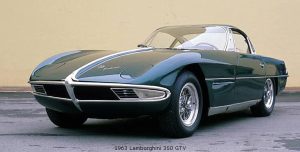
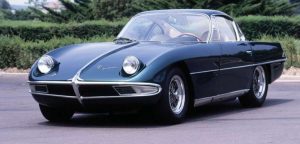
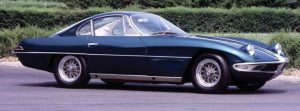
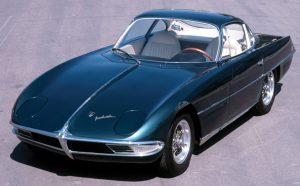

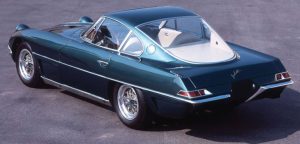
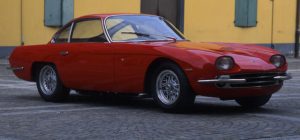



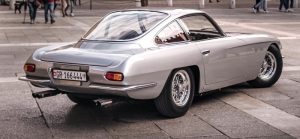
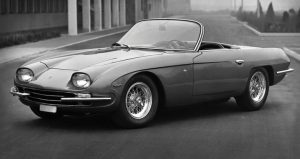



You must be logged in to post a comment.